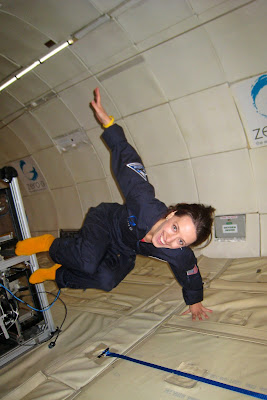In my line of work,
I'm asked about my “zero G” reduced gravity parabolic flight
experience often. I've been privileged to fly twice so far, both
times as a researcher. It was one of the coolest, most exciting
things I've ever done. I'm looking forward to flying again! I highly
recommend it to anyone, as a joy ride or as a microgravity
experience. It was exhilarating.
 |
| Graphic courtesy of my company, S3 |
As a physicist, I
can't bring myself to ever call these flights “weightlessness”
and I hesitate to even write “zero g.” I commonly use the term
“microgravity” when discussing payloads and experiments, but even that can be inaccurate. NASA uses the
term “reduced gravity” and ESA uses the term “parabolic,”
both of which are more accurate. Companies such as my own who cater to a
more general public tend to use catchphrase Zero G.
During these
flights, the aircraft is in a state of temporary freefall. To gain perspective, human-made satellites including the International
Space Station, the Moon, and everything that orbits Earth is in
freefall around Earth. Earth's gravity always exists but can be
canceled out, so it's more accurate to speak in terms of net gravity.
We drop the word “net” for convenience.
Weightlessness or
zero g (0 g) can only be achieved in perfection. Near to perfection, microgravity (0.000001 g)
conditions may exist in space, but not on aircraft flying through
Earth's turbulent atmosphere. The most these flights can hope to
achieve is centigravity (0.01 g), or if they're really good,
milligravity (0.001 g).
“Reduced gravity”
is accurate and accounts for lower gravity analogs such as lunar
gravity or Martian gravity, but ignores the hypergravity conditions
when the plane is flying upward at nearly double normal gravity (1.8
g). “Parabolic” is the most accurate term of them all
because it describes the motion of the aircraft as being large
parabolas or arcs.
My first flight was
on a Zero G Corporation plane here in Florida in November 2011. At
the time, I was studying for my doctoral candidacy exam and preparing
our experiment for flight, so I was preoccupied with technical
details and not focused on the flight itself. The closest I got to
contemplating my upcoming adventure was riding a theme park ride that
threw around my body and thinking, “Wow, these sudden G force
changes are good practice for next weekend.”
 |
| There is no sideways, not on this plane! - November 2011 |
It was very cold on
the plane. I soon learned that this was done on purpose to minimize
overheating which can lead to being sick. These aircraft weren't
given the nickname “vomit comet” for nothing. My flightsuit was
huge on my petite frame, but I pinned it well enough to be able to
move in it. I quickly learned that agility was beneficial while
floating around nearly uncontrollably as a first timer.
Microgravity isn't
like flying. It's not like swimming or scuba diving, even though
astronauts practice underwater to train for it. It isn't like being
at the top of a roller coaster. It was like someone flipped a switch
and gravity just turned off.
I had very little
control over my movements. Each move I made was exaggerated and
counter-intuitive. I felt like a rubber ball that had gone out of
control and was bouncing off of the floor, ceiling, and walls, only
in this case there was no difference between the floor, ceiling, and
walls, all were the same. I expected to fly like Superman or do
somersaults or just hover, but those maneuvers take practice. It was
all I could manage to keep control of my movements. I had a blast!
 |
| Houston, August 2012 |
 |
| About to board the plane - August 2012 |
My second flight was
in August 2012 at Ellington Field in Houston with NASA's Reduced
Gravity Program. I felt a lot calmer right off the bat because I knew
what to expect and how to react to reduced gravity. I was like a flag
blowing in the wind, only without wind. I held on to the experiment
with one hand while my legs stayed together and swayed horizontally
(for the most part) and my other hand worked.
Unfortunately, I
personally learned about the nickname “vomit comet.” I had
declined the optional anti-nausea medication for both flights, and
this time, the changing gravity caught up to me. By parabola 22 of
40, I was down and out. When we landed and I finally escaped the
plane, I literally got down on my knees and kissed the ground! But,
as sick as I was, I would sign up to do it again in a heartbeat.
Whether you're a
scientist or an engineer with an experiment or payload to test in
microgravity conditions or an average person with an adventurer's
spirit, I highly recommend signing up for a flight if you get the
chance. I'm so grateful for my flights. It'll be an experience you'll never forget!

No comments:
Post a Comment